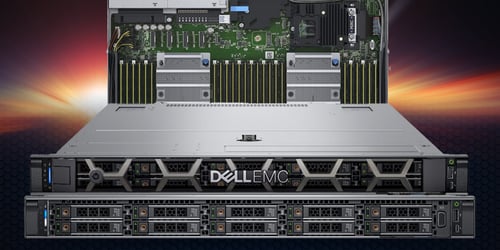Summary of Server Differences
For those that read the R640 vs R630 comparison, you may think we are just copying our notes, but it really is amazing how much Dell is able to stick in these servers with each new generation. Before you get too excited about the improvements, read all the way through to understand that these improvements come with a premium price. You will need to judge if they are worth it for your business.
With the Dell PowerEdge R650 vs the R640, the front and rear capabilities of the servers are basically unchanged. You have a choice of up to 10x2.5”or 4x3.5” up front and 2x2.5” in the rear of the chassis. Like the R640, with the R650, you can do SAS/SATA/NVMe for any of the 2.5” slots. I am sure there are some use cases for the 4x3.5” chassis, but I would almost always recommend moving up to a 2U chassis if you want large capacity 3.5” drives so you can either triple or even quadruple your capacity or save money by using more smaller capacity drives.
If NVMe drives are a consideration, you will be excited to know that Dell has added NVMe hardware RAID capabilities to the R650 via the H755 or H755N RAID cards.
Continuing with the drive differences, one of the most exciting features is the BOSS 2.0 card. The R640 introduced the BOSS card as an upgrade to putting your OS on SD cards. The R650 improves on that by allowing you access to the drives from the rear instead of having to open the server and they are hot swappable.
Memory is one of the areas where the R650 really stands out from the R640. You move from 24 DIMM slots to 32 DIMM slots. To help make space for the additional memory slots, they were able to remove the need for the expander card by pushing the RAID cards to natively allow for up 16 drives. When first reading up on the RAID cards, it was not initially clear why the increased SAS connectors was a big deal until we saw the increase in DIMM slots on the R650.
Another big area of improvement on the R650 is with GPU support. The R640 allowed for 3 NVIDIA T4 GPUs. The R650 allows for up to 3 of any 75W single width GPU. More and more applications are starting to make use of GPUs, so it is good to see that in the 1U chassis. Maybe we will see crypto miners starting to snatch up these servers.
And yet another upgrade on the R650, shared with all the 15th gen Intel servers, is with CPUs. Intel's new line of v3 scalable CPUs are pretty impressive. Leading CPU benchmarking source, Passmark, has the relatively low-end CPU for the R640, the Intel 4310, with a CPU rating 50% higher than the equivalent v2 processor, the Intel 4214. When you look at the gold processors of the v3 family, they often out score the platinum v2 CPUs. You can see a prime example of that by checking out the 6348 and 8280. The platinum v3 CPUs do a good job of pushing the core count to 40 cores per CPU. However, if cores really do matter for you, I would look at Dell R6515 and 6525 with AMD CPUs.
Click here to view a full comparison of the Intel CPUs.
All these upgrades do come at a price. As of the writing of this comparison, the R650 starts at $1,000 more than a comparable R640. If you do not need the upgrades, you can really save by going Dell Certified Refurbished R640 from xByte. Either way, contact xByte before your next IT project to understand what options you have.

